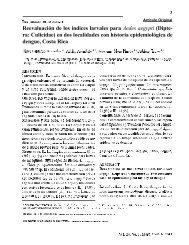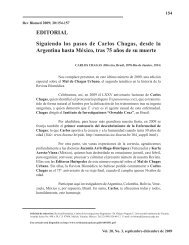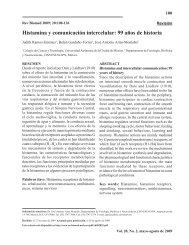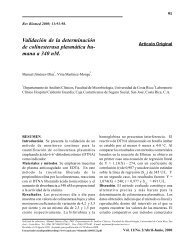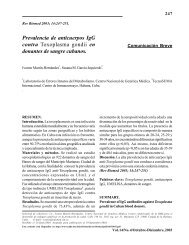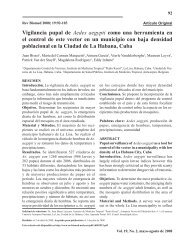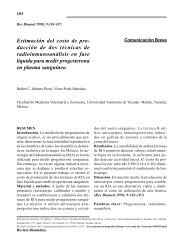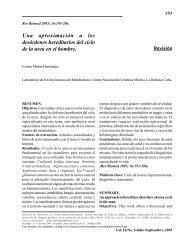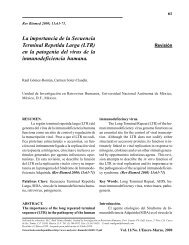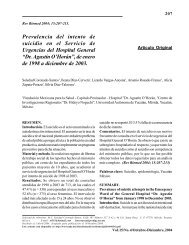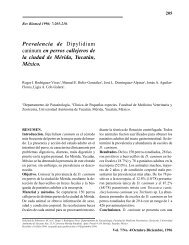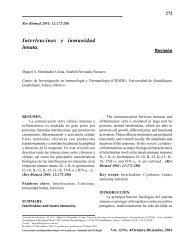Biochemical serum markers for Down syndrome screening. - Revista ...
Biochemical serum markers for Down syndrome screening. - Revista ...
Biochemical serum markers for Down syndrome screening. - Revista ...
You also want an ePaper? Increase the reach of your titles
YUMPU automatically turns print PDFs into web optimized ePapers that Google loves.
262<br />
IB Baluja-Conde, MR Rodríguez-López, O Zulueta-Rodríguez, B Ruiz-Escandón, et al.<br />
age of 35 years or older as the criteria <strong>for</strong> prenatal<br />
<strong>screening</strong>, most of the cases that occur in women<br />
under 35 years old remain undetected.<br />
Maternal <strong>serum</strong> <strong>screening</strong> is a non-invasive<br />
method. The objective of this <strong>screening</strong> is to reduce<br />
the proportion of women who have to undergo<br />
invasive diagnostic testing and, at the same time,<br />
increase the proportion of affected fetuses detected<br />
(10, 11). It relies upon the measurement of multiple<br />
biochemical <strong>markers</strong> (AFP, hCG, Ue3, free b-hCG,<br />
inhibin A, and pregnancy-associated plasma protein<br />
A (PAPP-A)), the calculation of the risk factor<br />
based on the parameters measured, and the<br />
mother’s age at the time of conception (12-18).<br />
Screening procedures vary from country to<br />
country. Controversy exists about the number of<br />
<strong>markers</strong> used and which combination yields the<br />
highest efficacy. Parental counselling is essential to<br />
insure in<strong>for</strong>med consent <strong>for</strong> further investigation and<br />
<strong>for</strong> any termination of pregnancy that may result.<br />
Several factors influence the accuracy of<br />
<strong>screening</strong> tests, including gestation dating method,<br />
maternal weight, number of fetuses, etc.<br />
<strong>Biochemical</strong> <strong>markers</strong> in maternal <strong>serum</strong><br />
<strong>for</strong> <strong>Down</strong> <strong>syndrome</strong> <strong>screening</strong>.<br />
The sensitivity and specificity of prenatal<br />
<strong>screening</strong> <strong>for</strong> DS have improved in recent years with<br />
the identification of new biochemical <strong>markers</strong> in<br />
maternal <strong>serum</strong>. Since the observation that <strong>serum</strong><br />
levels of alpha-fetoprotein (AFP) were reduced in<br />
women with fetuses affected by chromosomal<br />
abnormalities, numerous other fetoplacental <strong>markers</strong><br />
in maternal <strong>serum</strong> have been found to have altered<br />
levels in pregnancies with fetuses affected by<br />
aneuploidy (12).<br />
The most useful <strong>markers</strong> <strong>for</strong> prenatal <strong>screening</strong><br />
in the first trimester are the free b-subunit of human<br />
chorionic gonadotropin (hCG), and pregnancyassociated<br />
plasma protein-A (PAPP-A) (16-18,<br />
20, 21). Serum concentrations of the free b-subunit<br />
of hCG are higher than average, and PAPP-A<br />
concentrations are lower. In the second trimester<br />
intact human chorionic gonadotropin (13,16-19),<br />
<strong>Revista</strong> Biomédica<br />
alpha-fetoprotein (12,16-22), inhibin-A (15-19),<br />
and unconjugated estriol are used (14,18,19,21,22).<br />
Measurement of these <strong>serum</strong> <strong>markers</strong> has been<br />
proposed as a means of identifying pregnant women<br />
of all ages who are likely to have a <strong>Down</strong> <strong>syndrome</strong><br />
fetus. Women found to be at high risk would be<br />
offered confirmatory testing by karyotyping tissue<br />
obtained by amniocentesis or CVS.<br />
The <strong>serum</strong> levels of all these <strong>markers</strong> overlap<br />
in affected and unaffected populations, however,<br />
and so the odds that a particular value is associated<br />
with an affected pregnancy are used to modify the<br />
a priori risk specific to maternal age.<br />
A very important consideration in the <strong>screening</strong><br />
is the age of the fetus. The correct analysis of the<br />
different components depends on knowing the<br />
gestational age precisely. The best way to determine<br />
this is by ultrasound (8, 23-25).<br />
Once the blood test results are determined, a<br />
risk factor is calculated based on the “normal” blood<br />
test values <strong>for</strong> the testing laboratory. The average<br />
of normal is called the “population median”. Test<br />
results are sometimes reported to doctors as<br />
“Multiples of the Median" (MoM) (12, 22).<br />
The most effective approach to <strong>screening</strong> is to<br />
use combinations of <strong>markers</strong> (taking into account<br />
correlations between <strong>markers</strong>), and most protocols<br />
use AFP and either hCG or its b subunit, with or<br />
without unconjugated estriol (15,16, 23, 24).<br />
Examples of related tests: Maternal Serum<br />
Double Serum (maternal <strong>serum</strong> AFP, hCG),<br />
Maternal Serum Quadruple Screen (maternal <strong>serum</strong><br />
AFP, hCG, unconjugated estriol, inhibin-A) , and<br />
Maternal Serum Triple Screen (Maternal Serum<br />
AFP, hCG, unconjugated estriol) (21-25). These<br />
tests are carried out in the second trimester of<br />
pregnancy.<br />
In multiple marker <strong>screening</strong>, the “bottom line”<br />
maternal risk calculation <strong>for</strong> DS must start from<br />
accurate patient personal in<strong>for</strong>mation in order <strong>for</strong><br />
the interpretation to be valid. Each piece of<br />
in<strong>for</strong>mation about the patient and each of the<br />
laboratory analyte levels has equal weight in the<br />
algorithm used to calculate the DS risk (26, 27).



